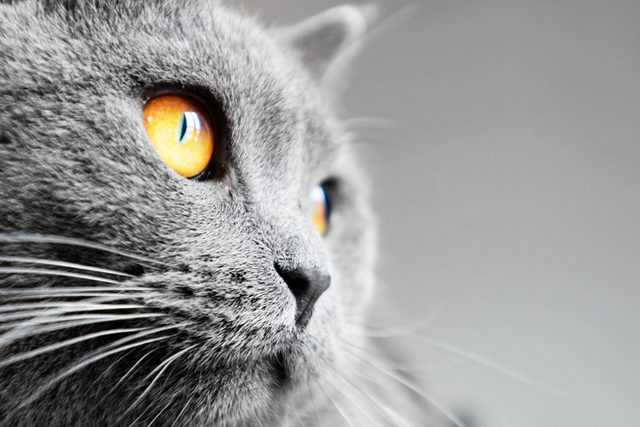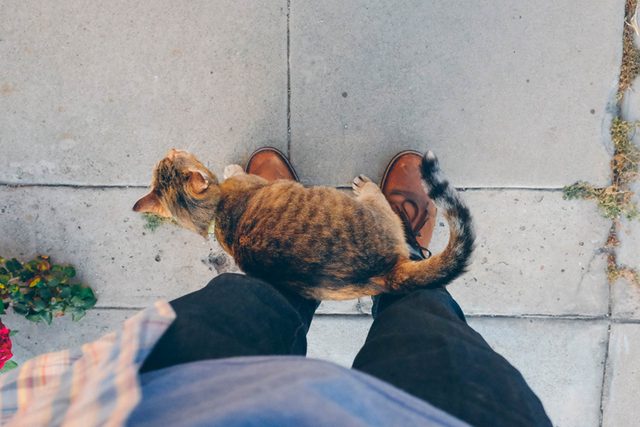Why Do Cats Knead?
An Explanation of the Weird Habit
Not all cats knead the same way, but there is a surprising reason behind this feline quirk.
Making biscuits, kneading dough, marching—whatever you call it, kneading is a classically quirky cat behavior. And if your kitty didn’t look so cute doing it, you’d surely be annoyed when it started kneading your favorite sweater or pile of clean laundry. Of course, all of this begs the question: exactly why do cats knead?
It’s one of the most commonly asked cat queries, like “Why do cats purr?” “Why do cats meow?” and “Why do cats rub against you?” To solve the mystery of kitty kneading, we asked the experts why our feline friends love to press their paws into every soft surface they can find.
How cats knead
First off, not all cats knead, and they don’t all knead in the same way. Most cats use only their front paws, but some use all four, or even just their back legs. Some kitties bring their claws out, while others don’t. A cat kneading at your lap might hurt, but your kitty probably doesn’t have any bad intentions; it just likes how you sound when you squeak. (You know, like a mouse.)
In all seriousness, if your cat kneads, you’ve probably noticed how relaxed it seems when doing so—almost as if it’s in a trance. A kneading cat is a happy cat. But why do cats knead when the action doesn’t accomplish anything? After all, “making biscuits” doesn’t actually lead to fresh baked goods.
Why do cats knead?
Even when they’re too young for their eyes to open, cute kittens need to knead, says Katy Nelson, DVM, a veterinarian with Chewy. Nursing kitties push on their mother’s abdomen when suckling to help their mother’s glands release more milk. No one is totally sure why the habit lasts through adulthood, but there are a few theories as to why cats knead.
For one thing, your cat might find it soothing. Felines grow up associating kneading with the comfort of their mama, and though they most likely don’t think about food when they’re kneading as adults, they still find it relaxing, as evidenced by the purrs you’ll probably hear as they’re doing it.
“Like a kid sucking a thumb, it’s a calming thing,” says Dr. Nelson. “A lot of cats have their eyes closed and look like they’re completely zenned out.” Maybe this is why cats sleep so much.
If you’re wondering what it means when a cat makes biscuits on you, know this: It’s a good sign. Kneading indicates a cat feels safe and happy around you—or maybe even considers you a mother figure!
 Jiri Foltyn/Shutterstock
Jiri Foltyn/Shutterstock
Another theory is that cats knead to mark their territory. Here’s a cool cat fact: Cats have scent glands on both their faces and their paws. When felines rub their faces against the furniture or go to town on a scratching post, they’re not just letting off steam or exploring the couch. They’re also leaving behind their scent.
The same happens when your cat kneads. Paws are the only places where cats sweat, which means rubbing them against something leaves behind their smell, says Dr. Nelson.
Other experts think kneading could be traced back to our sweet, domesticated house cats’ ancestors. Those wild cats didn’t have the soft blanket or fancy cat bed that your family pet got for its birthday, so they had to work a little to make the ground as comfy as possible, says Dr. Nelson. Pushing at the grass, leaves, or dirt might have helped soften it up to “get their bed just right,” she says.
 Evan Abram McGinnis/Shutterstock
Evan Abram McGinnis/Shutterstock
If you’re a cat owner who also owns furniture, you may spend less time wondering “Why do cats knead?” and more time asking “how can I get my cat to stop kneading?” Innocent as the habit is, it’s easy to get annoyed when your kneading cat digs its claws into your lap or furniture.
Kneading makes cats happy, says Dr. Nelson, so you should never stop your pet from doing its thing; just keep its claws short. “Keep the nails trimmed so it’s not painful and not messing up your blanket or your couch,” she says.
You could also try distracting your pet with an exciting new game—after all, everyone knows how much cats love boxes.
Source:
- Katy Nelson, DVM, veterinarian with Chewy
Originally Published: March 24, 2022